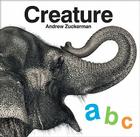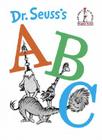I love alphabet books. I love them as literary works, engaging introductions to the alphabet, sources of great humor and writing sparks. There is no age limit to ABC books. As a teacher, I used them kindergarten through fifth grade – you just have to look around to see which books appeal to you.
Monday’s post offered a dozen books to explore. Next Monday will have a dozen more. But today I’m telling you about 3 more that missed my attention when I was compiling the other lists. I’ll use them as models for how to get the most fun out of whatever ABC book you’re reading.
My favorite thing to do with ABC books is to guess what is on the page that represents the featured letter. I do this whether or not I have a young reader with me! For the youngest kids, this gives essential opportunities to experience beginning sounds. As kids get older, they get to be detectives, searching the page for possibilities.
Dr. Seuss’s ABC is a perfect book for younger kids and older readers. It has the delightful prose of Dr. Seuss, plus lots of pictures on each letter page to discover beginning letter sounds. One other benefit of this book – the words are relatively easy to cover up so you can search for the letter pictures in the illustrations. Be aware: this book has some challenging pictures! For example, on the letter D page, who can find all these d-words? Doughnuts, dream, dozen, duck-dog. For family fun, take turns being the one-in-the-know.
 Creature abc by Andrew Zuckerman
Creature abc by Andrew ZuckermanThis is a beautiful and fun book. Although each letter is usually represented by only one animal, the photographs are gorgeous and sometimes you only see a part of the animal (chameleon tail, elephant leg, vulture wing…) before you turn the page.
 Q is for Duck: An Alphabet Guessing game by Mary Elting and Michael Folsom, illustrated by Jack Kent
Q is for Duck: An Alphabet Guessing game by Mary Elting and Michael Folsom, illustrated by Jack Kent
Oh, how I wish I’d seen this book when I was teaching! It is so clever, all my students would have loved it. The title tells it all – it is definitely a guessing book. After picking it up at the library, I didn’t even start the car until I’d read the whole thing. Not that I guessed everything. The book starts with A is for ZOO. Why? [next page] Because… Animals live in the Zoo. Some of the letters are fairly easy to guess, but some draw on your knowledge of animals.
These books are excellent models for creating your own ABC books. This is how I go about creating ABC books with kids:
- Read lots of ABC books.
- Brainstorm ideas for pictures that represent each letter. If your child is older, don't go too crazy with this. You want him to be clever with his own ideas and not give all of them away.
- Decide if this will be one family book or individual books.
- Decide what kind of book you want to create.
- A basic one-picture-for-each-letter book.
- A basic one-picture-for-each-letter book, all of the same category (animals, vehicles, dinosaurs...) This is a great opportunity to indulge in a passion.
- A many-pictures-for-each-letter book, either any category or a single one. This a chance to be quite clever, hiding pictures to be discovered.
- A Q is for Duck type book in which a characteristic of an animal (vehicle, food...) represents the letter. I've never tried this, but I can think of kids who would've loved this project.
- Decide on the format.
- A simple picture with letter and label, one per page.
- A picture and letter on one page, with the label on the next page (makes guessing easier).
- Several pictures on a page with the letter, with labels on the next page.
- Letter and part of a picture on one page, the rest on the next page.
- A Q is for Duck type book.
- Decide on illustrations.
- Hand drawn - stick figures are fine!
- Pictures cut from magazines.
- Pictures downloaded from computer.
- Pictures cut from coloring books.
I hope this gives you some ideas. Please share them in the Comments Box!
As you can see, ABC books offer some excellent literacy opportunities. Next Wednesday I’ll suggest more ideas.
Gail

No comments:
Post a Comment